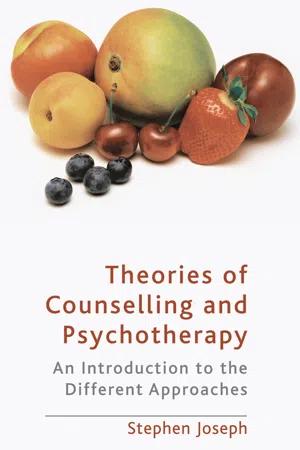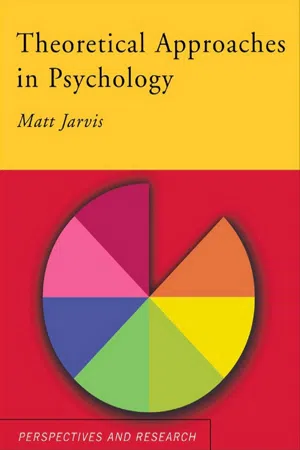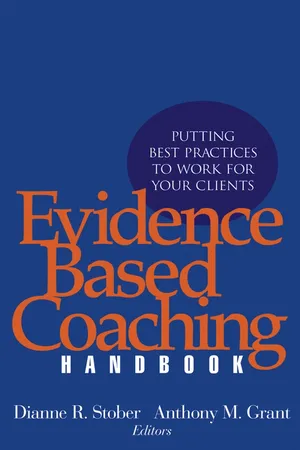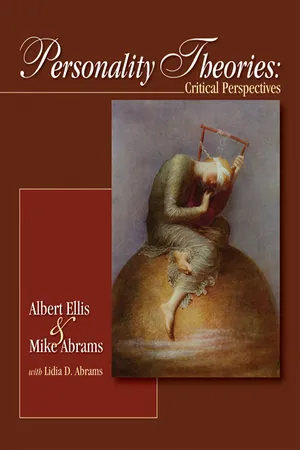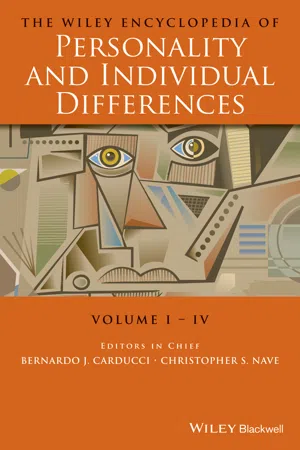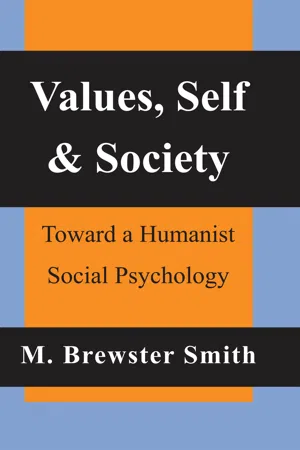Psychology
Humanistic Psychology
Humanistic psychology is a perspective that emphasizes the uniqueness and potential of the individual. It focuses on subjective experiences, personal growth, and self-actualization. Humanistic psychologists believe that people have the capacity to make choices and strive for personal fulfillment, and they emphasize the importance of empathy and understanding in therapeutic relationships.
Written by Perlego with AI-assistance
Related key terms
9 Key excerpts on "Humanistic Psychology"
- eBook - ePub
Theories of Counselling and Psychotherapy
An Introduction to the Different Approaches
- Stephen Joseph(Author)
- 2010(Publication Date)
- Bloomsbury Academic(Publisher)
Chapter 5Humanistic and Transpersonal Approaches
Introduction
Humanistic Psychology has been referred to as the third force in psychology, after psychoanalysis and behaviourism. It emerged in the middle of the twentieth century as a reaction against the previous ways of looking at human experience, which were seen as overly deterministic. Psychoanalysis was seen as painting a bleak and pessimistic view of human nature, in which people are basically selfish and driven by sexual and aggressive impulses which must be restrained. Behaviourism was seen as objectifying and dehumanizing the person and emphasizing environmental forces as determinants of behaviour. In contrast, the humanistic approach emphasizes human nature as essentially positive. The humanistic model emphasizes choices, values, and purpose in life. Problems are seen as resulting from not accepting personal responsibility for one’s actions. Humanistic therapies therefore strive to enable people to accept responsibility for their actions, to become aware of their subjective experiences, and to fulfil their potential for personal growth. Like behaviourism, early Humanistic Psychology took a scientific stance but, unlike behaviourism, began to question the traditional medical model. Rather than seeing the client as a passive recipient of expert help, therapeutic approaches in the humanistic tradition emphasized the choices made by the client and the client’s inner resources for change, as opposed to the techniques of the therapist.As Szasz says:People seeking help from psychotherapists can be divided into two groups: those who wish to confront their difficulties and shortcomings and change their lives by changing themselves; and those who wish to avoid the inevitable consequences of their life strategies through the magical or tactical intervention of the therapist in their lives. Those in the former group may derive great benefit from therapy in a few weeks or months; those in the latter may stand still, or sink ever deeper into their self-created life morass, after meeting with psychotherapists for years, and even decades. (Szasz, 1974, pp. 108–9) - eBook - ePub
- Matt Jarvis(Author)
- 2005(Publication Date)
- Routledge(Publisher)
Humanistic Psychology emerged through the work of Rogers and Maslow, who sought to create a third force in psychology to escape the restrictions of behavioural and psychodynamic psychology. They proposed a simple and optimistic psychology with a minimum of theory that would address what people described as important experiences. The major application of Humanistic Psychology is in counselling, where the experience of the individual is of paramount importance. Although the humanistic perspective remains important, it has limited influence in psychological research because of its untestable ideas and emphasis on the experiences of the individual.Look back at the three vignettes in Chapter 1. Now that you know a little more about the humanistic approach, reflect on how well a humanistic perspective explains each of these scenarios. You may find it helpful note down what aspects of each situation a humanistic approach can explain fully and where it runs into difficulties.Further reading
Merry, T. (1995) Invitation to Person-centred Psychology, London: Whurr. Designed for the lay-reader as well as the student, this is a readable outline to the nature and application of Humanistic Psychology.Thorne, B. (1992) Carl Rogers, - eBook - ePub
Person-Centred Counselling Psychology
An Introduction
- Ewan Gillon(Author)
- 2007(Publication Date)
- SAGE Publications Ltd(Publisher)
In this chapter we shall consider the relationship between the person-centred approach and each of these four paradigms, focusing on how person-centred therapy relates to their core assumptions as well as the therapeutic theories and practices they encompass. The chapter represents nothing more than a snapshot of such relationships, and is thus a generalised account rather than a comprehensive overview. Furthermore, the limited extent to which we are able to explore the complexities of each paradigm means that the chapter cannot purport to provide a detailed analysis of these, but instead offer only a basic summary of each. Such an outcome is not ideal, but an inevitable product of our focus being person-centred therapy rather than counselling psychology per se. Any reader wishing a more comprehensive understanding of the therapeutic paradigms presented here, or indeed the therapeutic approaches they encompass, is advised to consult more complete accounts, such as those contained in Woolfe. et al. (2003). Our exploration will instead attempt to summarise the place of the person-centred approach within its counselling psychology context, which is an important undertaking in terms of our goal to explore person-centred therapy from a psychological perspective. Our starting point for this is the humanistic paradigm, and the relationship of the person-centred approach to it.The humanistic paradigmThe humanistic paradigm emerged in the USA during the 1950s and 1960s, and rapidly become known as the ‘third force’ (Bugenthal, 1964) in psychology due to its philosophical differences with behaviourist and psychodynamic standpoints, the first and second forces respectively. In many ways, Humanistic Psychology was a reaction to these two forces, rejecting the Freudian emphasis on destructive, unconscious urges and the over-simplified, laboratory based analyses provided by behaviourism. For Bugenthal (1964), the humanistic paradigm evolved on the basis of five fundamental postulates (or principles). These are:- Human beings, as human, supersede the sum of their parts. They cannot be reduced to components or isolated elements.
- Human beings have their existence in a uniquely human context, as well as in a cosmic and ecological setting.
- Human beings are aware, and also aware of being aware – i.e., they are conscious. Human consciousness always includes an awareness of oneself in the context of other people.
- Human beings have some choice, and thus responsibility.
- Human beings are intentional and goal-orientated. They are aware that they cause future events and seek meaning, value and creativity.
While each of these postulates highlights a specific aspect of humanistic thinking, they also hint at an underlying philosophy encompassing a small number of core themes. For example, the proposition that human beings are something more than the sum of their parts (i.e. cannot be reduced to components) reflects the theme of holism, a standpoint stressing the importance of viewing people as unique - eBook - ePub
Humanistic Psychology
Current Trends and Future Prospects
- Richard House, David Kalisch, Jennifer Maidman, Richard House, David Kalisch, Jennifer Maidman(Authors)
- 2017(Publication Date)
- Routledge(Publisher)
In many ways, Humanistic Psychology is now part of the mainstream, rather than being something new and unfamiliar. It is no longer unfashionable to admit that you are interested in understanding yourself and what you might be or become. In fact the ‘new’ positive psychology movement (Snyder & Lopez, 2002) has much in common with Humanistic Psychology, and the ‘new’ approaches to coaching (Cox, Bachkirova & Clutterbuck, 2010) have taken much from the humanistic tradition, particularly when working with organizations.Today there are fewer growth centres than there were, partly because the approach has been adopted much more widely. Certainly, most courses that are concerned with training people to deal with others now include some emphasis on understanding yourself, and they use humanistic thinking and humanistic methods – often unacknowledged. They have to, because any attempt to understand or work with others on any kind of emotional level has to involve some self-understanding, some self-awareness. And this is the heartland of Humanistic Psychology.But the decline in growth centres can also be related to the increase in professionalization and of teaching people how to fit better into the status quo. Thus while much has been absorbed into the mainstream from Humanistic Psychology, many of the more radical assumptions of Humanistic Psychology have been left behind. Humanistic notions such as the importance of self-development for its own sake, of evolution throughout life, of the wholeness of the individual, of creating democratic groups and communities with open and honest communication, indeed of the idea that authenticity and the real self matter more than success, have in many cases fallen by the wayside.It might, therefore, be more necessary than ever that Humanistic Psychology become the standard bearer for a radical vision of what it means to be human.References
Alderfer, C.P. (1972) Existence, Relatedness, Growth, New York: Collier-Macmillan.Anthony, Dick, Ecker, Bruce & Wilber, Ken (1987) Spiritual Choices, New York: Paragon House.Assagioli, R. (1975) Psychosynthesis: A Manual of Principles and Techniques - eBook - ePub
Evidence Based Coaching Handbook
Putting Best Practices to Work for Your Clients
- Dianne R. Stober, Anthony M. Grant, Dianne R. Stober, Anthony M. Grant(Authors)
- 2010(Publication Date)
- Wiley(Publisher)
TRANSLATION FOR COACHING As coaches, then, we have the opportunity at the outset of the development of coaching theory, research, and practice to learn from the psychotherapy literature and maintain the importance of focusing on the development and understanding of a trusting relationship between coach and client. Rogers’ emphasis on the importance of accurate empathy and unconditional positive regard, along with his and other humanistic theorists’ stress on authenticity both between practitioner and client and within each are critical guides for effective coaching practice. Within coaching, as in psychotherapy, there is recognition that without the client feeling understood and accepted, the chances for coach and client to work together for change are pretty slim. Likewise, failure to give any feedback in coaching conversations regarding what the coach experiences in the interaction is withholding an important source of information to the client. The main difference in how these qualities are demonstrated by the coach is that the coach employs them in the service of building rapport such that clients can actively engage in making choices about the actions they will take in their growth. This contrasts with the therapeutic aim of these qualities, providing a context for increasing awareness in the service of healing.HOLISTIC VIEW OF THE PERSON
Another defining characteristic of the humanistic perspective is the emphasis on viewing people holistically. There is a rejection of a split between mind and body; rather there is an emphasis on the individual as a dynamic whole. Humanistic theorists would liken descriptions of parts (e.g., cognitive functions, emotional states or traits, etc.) as helpful in understanding the full person like anatomical study is helpful in understanding a living, moving body: It can give a particular view but is not adequate in understanding the whole. When we are functioning at our best, we generally describe this state as feeling “whole,” “integrated,” or in “flow” (Csikszentmihalyi, 1990).Range of Human Experience
Most humanistic theorists explicitly state that in order to reach full potential, individuals must value the full range of human experience: our physical, cognitive, and affective, or emotional, realities (Cain, 2002). And since there is often an overreliance on intellectual, cognitive processing, many humanistic approaches stress the importance of emotional and physical processing (e.g, Elliott & Greenberg, 2002; Gendlin, 1996; Mahrer, 1996; Rice, 1974). Overall, humanistic approaches share the view that if attention is not paid to all of our experience, growth is interrupted.TRANSLATION TO COACHING For application in coaching, this view is extended to the idea that we cannot see our clients unidimensionally; rather, we tend to look at all areas of our clients’ experience. Where humanistic therapists may focus on micro-level experiences, such as “What are you aware of in this very moment?” in order to access immediate experience, the coach may focus on a more macro view of the client’s experience and, as needed, inquire about internal states as they impact the broader picture. Thus coaches attempt to understand the client’s experience of self (e.g., values, personality, goals, health, etc.); of self-in-relation (e.g., important relationships, interpersonal style, sense of community, networks, etc.); and of environment (e.g., work/career environment, financial situation, physical surroundings, etc.); and each in relation to the other. By approaching our clients in this way, we communicate to our clients that their whole experience is of interest, is important, and is worthy of attention. Of course, this requires the caveat that the focus in coaching also is dependent on what is part of the coaching contract. The aim of coaching may be broader in a personal coaching relationship, while in a performance coaching scenario the focus may be more circumscribed (or not!). - eBook - ePub
Ordinary Ecstasy
The Dialectics of Humanistic Psychology
- John Rowan(Author)
- 2015(Publication Date)
- Routledge(Publisher)
But in fact the two things are like chalk and cheese. The main plank in Humanistic Psychology is the integration of body, feelings, intellect, soul and spirit, and it says so very clearly in all the introductory leaflets put out by AHP affiliates in various countries around the world. This integration is the key to what we call self-actualization, and all our workshops touch on it in some way. The secular humanists, on the other hand, are often not much interested in the body or in feelings, and actively deny any existence to the spiritual or transpersonal aspects of our life.I actually joined the British Humanist Association (BHA) at one time, to See whether any links could be made, but I found the people involved in it to be aridly intellectual, unawarely sexist and very narrow, spending a lot of their time and energy knocking Christianity, and some of the rest on issues like abortion and euthanasia. I lasted a year and walked out in protest at the sexism expressed at the Annual General Meeting.Now it may well be that secular humanism should not be judged by the activities of the BHA (or the National Secular Society, which it much resembles) because humanism is itself a much wider philosophy. Nevertheless, the BHA is trying to represent it, and there must be some connection somewhere. None of these things is Humanistic Psychology.Passage contains an image
2 Humanistic Psychology is and is Not Optimistic
When people first come across Humanistic Psychology, they usually find it presented as full of blue-sky optimism. This is because the presentation is restricted to Abraham Maslow and Carl Rogers. What I want to say here is that Humanistic Psychology is not restricted to these, but also includes people like James Bugental, Rollo May, Kirk Schneider and Alvin Mahrer who are not particularly optimistic at all.Maslow and Mahrer
Abraham Maslow is a very important pioneer figure in Humanistic Psychology. His theory of human needs and human development says that there is a normal process of growth which applies to all people (see Table 2.1 - eBook - ePub
Personality Theories
Critical Perspectives
- Albert Ellis, Mike Abrams, Lidia Dengelegi Abrams(Authors)
- 2008(Publication Date)
- SAGE Publications, Inc(Publisher)
This restriction led some psychologists to find the dominant view far too limiting. They maintained that behaviorism had eliminated some of the most important dimensions of the human psyche. This point of view had been indirectly supported in an earlier generation by such psychologists as Max Wertheimer, Kurt Koffka, and Wolfgang Köhler. These theorists are generally credited with developing the Gestalt (from the German word for form or shape) approach to experimental psychology. Humanistic Psychology—A “THIRD FORCE” What gives life meaning? What makes us human? Love and hate, hope and fear, happiness and sorrow, satisfaction and creativity. These essences of what it means to be human are not amenable to operational definitions. How can one explain the human need for independence and creativity through laboratory experiments? Even if they cannot be proved, can a psychology that ignores them really be a “human” psychology? The first president of the American Association for Humanistic Psychology, James Bugental (1967), described the goal of Humanistic Psychology as providing “a complete description of what it means to be alive as a human being” (p. 7). Humanistic Psychology was—in the mind of one of its pioneers, Abraham Maslow—a “third force,” created to battle with the established forces of behaviorism and psychoanalysis. It sees behaviorism as seeking to reduce the human to a large rat and as having nothing to do with the human experience. It sees psychoanalysis as the study of only disturbed individuals; studying only the disturbed will, in the words of Maslow (1970, p - (Author)
- 2020(Publication Date)
- Wiley(Publisher)
I think, therefore I am, comes first, the existentialist may ask, “What is the first word in your sentence? ‘I’ has to be there before you can think.” An existential position might be that we are “thrown” into existence (perhaps by a deity, perhaps not), and from the moment we are born must make the decision to breathe and live, or not breathe, and die. From that instant on, existentialists say, though certainly at a cognitively naïve level in the beginning, we are responsible for choices in our lives. The humanistic psychologist embraces the existential credo that we have free will and are our own life designers. Another way to say it is that we are brought (or thrown) into existence without a predestined life prescription, and are steadfastly – though sometimes unevenly – devoted to refining our essence. Therapy, in that existential sense, is a process of helping to open one up to his or her natural potential.Relationship
Humanistic therapists tell the apprentice that therapy is about the relationship, no techniques, no manipulation, no advice giving, and by encouraging choice, no behavior modifying (Glasser, 1998). Often the questions are asked, “But what do you do? How does it work? What do you say?” Historically, the humanistic‐existential therapist has evaded such questions with responses such as: “You create a climate where the client feels safe. You prize the client. The client has a natural, organismic drive toward health. We are all self‐correcting organisms. The relationship you create is what heals.”Since steps are not specifically spelled out, it is possible that the budding humanistic therapist may become frustrated and turn to more prescriptive approaches such as behaviorism or psychoanalysis. Humanistic professionals, however, see compelling reasons to select the humanistic‐existential approach either for a client or a new student therapist.Maslow (1954 ), considered a leading architect of Humanistic Psychology, proposed a hierarchy of motivational needs, from the lower‐order physiological needs (food, shelter, and safety), to the psychological needs (love, belongingness, and self‐esteem), to the higher‐order growth needs (aesthetic needs and needs to know), and finally, what Maslow labeled self‐actualizing needs. In Maslow’s chart, one may only address the higher‐order needs if the lower‐order ones are at least minimally satisfied. What appeals to clients seeking therapeutic help is the nonjudgmental aspect of Maslow’s self‐actualization, and its egalitarian application in Rogers’ person‐centered approach. It is not a competition, but a striving toward one’s own highest potential. Some people in the psychology field consider Viennese psychiatrist Alfred Adler to represent the origins of the Humanistic approach, though Adler was gone long before the Old Saybrook founding meeting of the Association for Humanistic Psychology. In contrast to Freud, Adler was considered a social psychologist that emphasized cultural involvement, family influences, birth order, and the rise from an inferiority position (born toothless, hairless, unable to speak, etc.) toward a life‐goal of superiority. Adler also may have been the first truly feminist psychologist, who was quoted in The New York Times as far back as 1935 saying that women’s being inferior to men was a colossal myth (Adler, 1935- eBook - ePub
Values, Self and Society
Toward a Humanist Social Psychology
- Mahlon Brewster Smith(Author)
- 2017(Publication Date)
- Routledge(Publisher)
Gemeinschaft, a predicament heightened for recent Americans by the decisive break with history in a nuclear and electronic age, by our national entanglement in a demoralizing war, by the assassination of our most hope-inspiring leaders, by the undermining of former bases for hope and commitment as the previously unchallenged doctrine of unending growth and progress becomes visibly untenable. As the practicing humanist Robert Penn Warren (1975) has written, “Any true self is not only the result of a vital relation with a community but is also a development in time, and if there is no past there can be no self” (p. 56). Since our ties to community in time have been strained and attenuated, our age has not been friendly to integral, well-rooted selfhood.The Humanistic Psychology Movement
In order to be in a position to discuss the involvement of the encounter-group movement with Humanistic Psychology, I need first to review the background of the humanistic movement in American psychology, a revolt against the positivistic behaviorism that by midcentury had long dominated academic psychology and also a revolt against psychoanalysis, which provided a major theoretical basis for the rapid postwar growth of clinical psychology. There had long been a minor current of “abnormal and social psychology” that coexisted uncomfortably with the mainstream of positiv-istic experimental psychology. Out of this current emerged the psychology of personality in the late 1930s, under the leadership of such major figures as Allport (1937) and Murray (1938), soon to be joined by Murphy (1947), Maslow (1954), Kelly (1955), Rogers (1961), and May (1977).All of the eminent psychologists just named, together with Charlotte Buhler (1933), who while still in Vienna had launched the study of lives in life-span perspective, met with various other psychologists and humanists in a conference at Old Say brook, Connecticut, in 1964 that formally launched the Humanistic Psychology movement as a “Third Force” distinct from the then-regnant forces of behaviorism and psychoanalysis: a movement to bring psychology back to concern with human experience, values, and choices; to counteract the alienating stream of mechanism in psychology; to balance the concern wth pathology with a focus on positive human potentialities for love, creativity, and fulfillment (May, 1975). While apostles of the European philosophical currents of existentialism and phenomenology were among the group, it is important to recognize that it also included the entire academic leadership of personality theory, apart from strict Freudians, in what (in retrospect) now appears to have been its great period.
Index pages curate the most relevant extracts from our library of academic textbooks. They’ve been created using an in-house natural language model (NLM), each adding context and meaning to key research topics.
